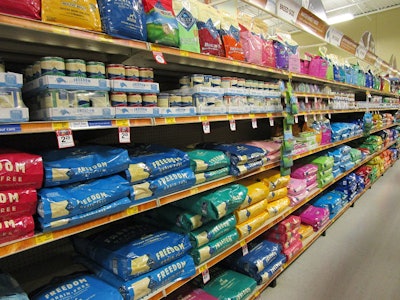
It’s been less than a year since a major pet food acquisition – General Mills buying Blue Buffalo – caused waves in the market, and we’re seeing its continuing influence. Having one of the largest mass market consumer goods companies as a parent has significantly shifted Blue Buffalo’s distribution and sales: In its first fiscal half of 2019, General Mills reported that, while retail sales of its pet foods increased 9 percent overall, they declined by double digits in the pet specialty channel – meaning the sales increases came in mass market. (E-commerce sales growth, also very robust, was reported separately at 30 percent.)
Of course, Blue Buffalo started expanding into the food, drug and mass (FDM) channel a full six months before its acquisition, possibly even to make it more attractive to a buyer like General Mills. Who knows, perhaps they were already in talks at that point?
Regardless, Blue Buffalo’s continuing shift toward FDM and away from pet specialty – General Mills’ second quarter earnings presentation also included the statement that the company plans to double Blue Buffalo’s distribution and product assortment in mass market outlets – is just another sign of how rapidly, and dramatically, the pet food market landscape is changing.
Breaking exclusive bond with pet specialty
Unsurprisingly, the largest impact of this change seems to be landing on pet specialty retailers. Blue Buffalo was once a favorite in that channel, and the company previously had claimed to be pet specialty’s top food brand, according to Mark Kalaygian, publishing director and editor in chief of Pet Business. That is no longer true.
For these retailers, especially smaller independents, the low margins on pet food make it difficult for them to compete on price with other outlets (not just e-commerce and FDM but also pet chain stores); they have traditionally competed and differentiated by offering exclusive, superpremium pet food brands. Once a pet food brand breaks that bond of exclusivity, many independent pet retailers are quick to drop the brand and replace it with another.
That’s been the case since Procter & Gamble bought Iams back in 1999 and expanded its distribution into FDM in only a year. The backlash by pet retailers was fairly swift, and they’ve not hesitated to follow that same path ever since when a new parent company (in most cases) decides to move a premium or superpremium brand into other channels. (Consumers of the brand often are not happy about such moves, either.)
The same thing happened when Blue Buffalo announced in August 2017 that it was taking its Blue brand into several mass market retailers. By November of that year, the end of the company’s third fiscal quarter, it was already reporting some pet specialty retailers had pulled Blue Buffalo’s promotions, canceled off-shelf activity and delayed purchase orders of the company’s products. Consequently, sales growth in that channel had already fallen to only 1 percent at that point. It seems pet specialty retailers have since helped hasten that decline, aside from any distribution changes in the channel that General Mills has made since the acquisition.
Questions for the pet food market to ponder
While still a separate company, Blue Buffalo had been reporting slower sales growth in pet specialty, at least in pet superstores, by its second fiscal quarter of 2017, so it’s understandable why it started looking at the mass market, in addition to the booming e-commerce channel. Under General Mills, those moves have only accelerated. Does the company plan to just gradually withdraw from pet specialty, eventually disappearing entirely from that channel? As Kalaygian noted, the channel was barely mentioned in General Mills’ recent earnings report.
More importantly, what do all these channel shifts mean for the overall pet food market? Will other, larger pet food brands and companies start to follow General Mills’ lead – and if that happens, can pet specialty survive, let alone thrive? Or, does the departure of a significant player like Blue Buffalo just open up opportunity and pet specialty retail space for other brands, at least in the short term, attracting pet owners like millennials who, while digital natives, also seem to appreciate in-person experiences?
It will be interesting to watch as this scenario plays out.
















